Rowing machines seem pretty simple to operate. You sit down, strap your feet in, grab the handle, and pull. Rinse, and repeat. But that’s not the whole story. There’s a difference between using a rowing machine and using a rowing machine properly.
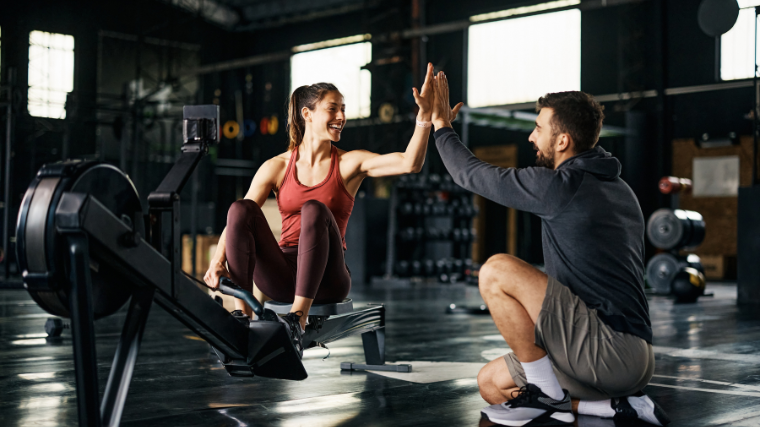
When you use rowers correctly, these machines can give you everything from a warm-up or active recovery cardio session to a high-intensity conditioning workout. All of this, you can get without the repetitive pounding that the pavement gives your joints when you head out for a run. Here’s how to use a rowing machine to maximize your conditioning and strength in the gym.
Editor’s Note: The content on BarBend is meant to be informative in nature, but it should not be taken as medical advice. When starting a new training regimen and/or diet, it is always a good idea to consult with a trusted medical professional. We are not a medical resource. The opinions and articles on this site are not intended for use as diagnosis, prevention, and/or treatment of health problems. They are not substitutes for consulting a qualified medical professional.
How to Use a Rowing Machine
Watching that CrossFitter in your gym perform pull after smooth pull on the rower might make it look easy — or intimidating. Either way, you’ll need to know how to use it properly before getting after your own rowing workouts.
- Set the Drag: You set the drag — how much resistance you’re getting during your workout — with the damper, generally located on the right side of the flywheel. Generally, even very experienced rowers tend to keep the drag to between three and five.
- Position Your Feet and Hands: Sit down on the seat. Secure your feet into the straps on the foot pads, adjusting the size if needed to ensure that the strap is over your midfoot. Lean forward to unhook the handle and take it into your hands. Hold it loosely but securely with straight wrists.
- Catch: With your arms straight and your head in a neutral position, lean your upper body forward. Initiate the lean with your hips until your shoulders are in front of your hips with your knees bent and your seat as close to the flywheel as you’re going to get. Let your heels lift.
- Drive: Drive down with your feet, explosively straightening your legs. Keep your shoulders relaxed and away from your ears with straight arms and a neutral spine. Lean back slightly as your knees begin straightening.
- Finish: As your knees are about to become straight, transition the pull into your arms. Lean back slightly, using the power of your back to pull the handle to finish slightly below your ribs. Make sure your wrists stay loose but straight.
- Recover: Lean forward again, extending your arms back out. Once your hands pass in front of your knees, re-bend your legs. Continue sliding forward in the seat until you reach the catch position again. Repeat from there.
Keep the transition between strokes as smooth as possible. Try to keep each part of the pull at a relatively consistent pace and level of effort.
The Parts of a Rowing Machine
Rowing machines aren’t all the same. Some fold up to be nice and compact while others are fairly immovable beasts. While some rowers use air or magnets to create resistance, others use water.
Certain rowers have fancy displays that can link to specific workouts or even apps that can help you with your motivation and routine. Other machines have displays that no one would call fancy, but they’ll get the job done.
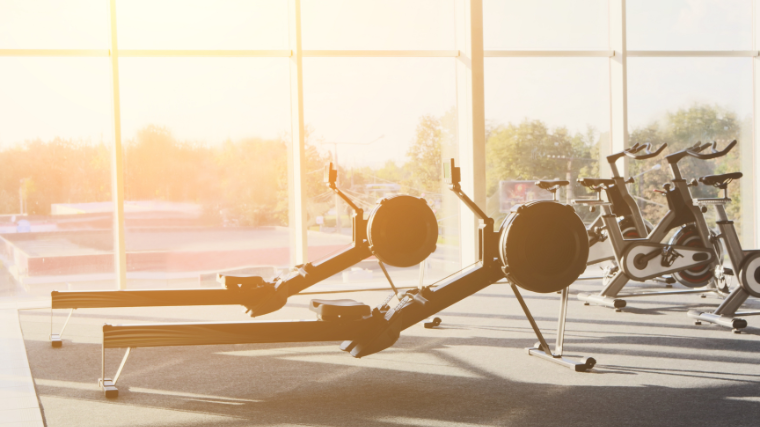
But pretty much whatever kind of rower you find yourself on, you’re still going to find the same types of components onboard. Here’s what you need to know about the parts of a rower that you’ll be looking at once you sit on the seat.
Flywheel
The flywheel is that big circular piece that dominates the front of a rowing machine. If your rower uses air or magnets to create resistance, the flywheel will generally be oriented like a car wheel. With water-based rowers, the flywheel is likely to be oriented horizontally laid across the top of the frame.

This is where that big old whoosh sound comes from every time you pull. It’s also what allows air to flow with the machine— which is where the damper comes in.
Damper
The damper will generally be located on the side of the flywheel. It often takes the form of a small lever, and will give you the option to set it to a number between one and 10. These numbers do not indicate resistance. Instead, the damper numbers are about the amount of air that can flow into the flywheel. You’ll likely want to keep the damper set between three and five.
Straps or Footplates
There are generally two adjustable pieces pertaining to your feet on a rower. The first is the strap, which you’ll secure like a buckle around your midfoot. The other component is the footplate itself, which is often adjustable. Like a foot-measurer that someone might use in a sneaker store to determine your shoe size, rower footpads typically have an adjustable height.
Adjust as needed so that your heel is snug against the bottom groove of this adjustable piece. You’ll want to make it so that the strap falls across your midfoot, rather than higher or lower on your foot.
Display
Just as all rowing machines aren’t made equal, neither are all displays. Some rowers come with different features than others, but most rowers will have a monitor that automatically starts when you begin rowing.
You can often toggle, using the buttons on the screen, to monitor different metrics on the display; for example, some rowers report a stroke-by-stroke visual representation of our force output. On others, you’ll just be able to look at the number of meters you’ve rowed, your 500-meter pace, and your stroke rate.
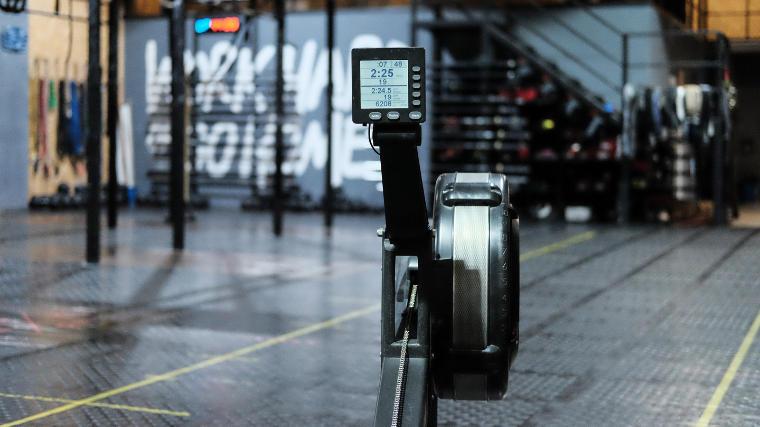
Your 500-meter pace will have a time indicated in minutes, followed by a /500m marker. So, if you’re rowing at a pace that will have you completing 500 meters in 2 minutes and 24 seconds, your 500-meter pace will read “2:24/500m.” Your stroke rate is indicated with s/m — your strokes per minute.
Handle
The handle is attached to a chain or belt and will typically rest in a little groove in front of the flywheel. Hold the handle in a comfortable overhand grip with both hands. There’s no need to squeeze the handle — as long as your grip is secure, you’ll benefit most from keeping your hands and shoulders relaxed. Make sure your wrists stay straight, even at the end of the drive.
Common Rowing Machine Mistakes
Just because someone is putting up impressive rowing numbers doesn’t mean they’re rowing at optimal efficiency. Make sure you’re not making any of these common rowing machine mistakes to make the most out of your rowing workouts.
Setting the Drag Too High
It’s tempting to crank the damper up to 10, especially if you’ve been practicing rowing for a while now. The instinct makes sense — the principles of progressive overload dictate that adding more weight over time may not be the only way to get stronger, but it is certainly an effective way to get stronger. Adding weight to the bar is also something many — if not most — lifters actively desire.
But the drag isn’t equivalent to weight on the bar. The damper does not indicate resistance on a rowing machine. Instead, resistance is provided by the speed at which you’re pulling. The stronger your pull, the stronger the resistance.

Pulling at a 10 requires a tremendous amount of power, which can set you up for injury because it’ll require a huge amount of buy-in to generate each stroke. High-level rowing athletes often perform their 2,000-meter row tests with the drag set in the middle, around five or six.
Over time, progress by playing with your cadence, sprinting efficiency, and distance endurance with the damper set at a consistent level. Generally, you’ll want to set your damper between three and five. Setting it much higher will likely cause a form breakdown and might increase your risk of injury.
Leaning Too Far Back
To get the most mileage out of each pull, it might seem to make intuitive sense to lean as far back as you can as you finish. But that’s actually not going to get you what you want.
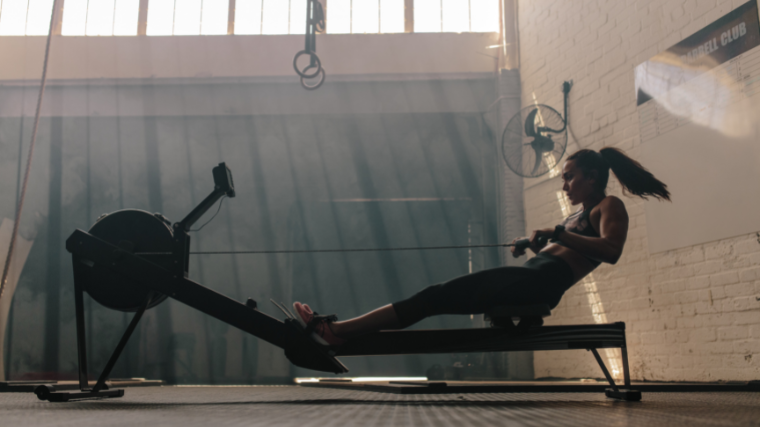
[Read More: The Best Leg Exercises for Your Next Leg Day]
Leaning back too far will make you take longer to move into the next stroke. The closer to horizontal you lean — the farther back you go — the less efficient your strokes will have. Instead of leaning back with abandon, only go slightly back to finish your pull.
All Arms, No Legs
The majority of the strength in your row comes from your legs. You’ll be generating this force during the first part of your row — the drive. It might seem intuitive to initiate the drive with your arms. Your hands are, after all, what’s holding the handles. But make sure you don’t tug with your arms before it’s time for them to pull.
Only bend your elbows after your knees extend so that your arms are finishing the pull instead of starting it. That way, each part of your body will do its part at the right time.
All Legs, No Arms
On the flip side, you might push off with your legs so hard and fast that your arms don’t get a chance to be properly involved. Finishing the stroke with a strong pull from your arms — with the majority of the force coming from your back — will give you the most efficient stroke.
When you’re going for total body strength, this portion of the lift will also directly involve your back. You’ll make your back stronger with this finishing stroke, so it’s really not something you want to skip. As your legs reach full extension, bend your elbows to finish the row.
Going Too Fast
Faster is unlikely to be better, especially if you’re new to rowing. Just like setting the damper too high, a higher stroke rate isn’t necessarily better. You don’t want to be tiring yourself out unnecessarily. Extremely elite rowers may be able to maintain a consistent stroke rate of around 36 to 38 strokes per minute. If you’re pushing past 32 per minute for anything but a short sprint, you may want to focus on quality instead of quantity.
Rowing Machine Form Tips
You can know what to do and how to do it — but with movement as complex as rowing on the erg, a few extra tips probably won’t go amiss.
Let Your Heels Lift
When you’re squatting or deadlifting, you need your heels to stay down. When you’re performing other types of rows — whether with barbells, dumbbells, or kettlebells — you also want your heels to stay connected to the ground the entire time. But this is a dynamic form of rowing that isn’t like its namesake cousins.
When you’re using a rowing machine, it’s often best to let your heels lift up during the catch phase. That’s when your legs are bent and your body is as close to the flywheel as you’re going to get. Letting your heels lift off will help give you a stronger leg drive to push through your whole foot with full force.
Keep Your Movements Fluid
When you’re working with barbells, you often pile a whole lot of effort into the initial push or pull and pause at the top or bottom of the lift. For example, you’ll squat down and then pause briefly when you stand up before sinking back down into your next rep. You’ll also take a brief pause once you’ve locked out your deadlift before going into the next rep.
While that works to keep your form clean and tight with barbells, you don’t need the same logic on the rowing machine. Keep your movements as fluid as possible, aiming to maintain consistent movement throughout your pull and recovery. Don’t pause after your pull in the finished position before starting recovery. Instead, move right into your next stroke.
Maintain a Linear Stroke
You’ve heard of the bar path with barbell work. In rowing, there’s a path you want to keep with the handle. As with a barbell, you want this to be linear — forming one solid line instead of bouncing all over the place.
If you bend your knees right away when you finish your stroke, you’re bound to run into a problem. With bent knees, you’ll need to lift the handle up and over your kneecaps in order to let the handle come back toward the machine. This will cancel out the efficiency of the stroke.
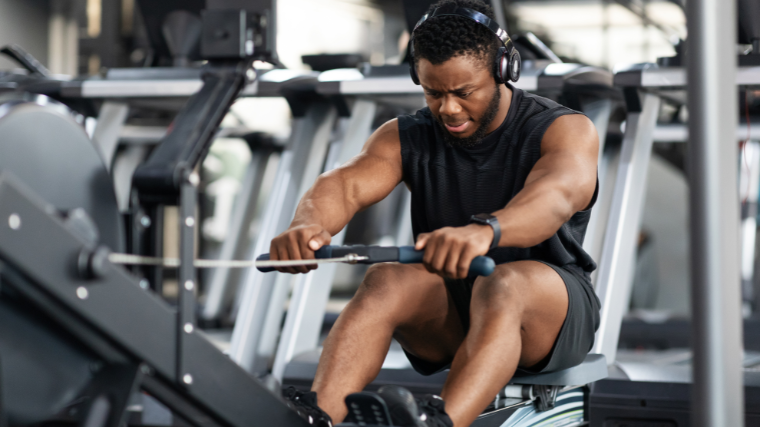
Instead, wait for your hands to pass in front of your knees before you bend them in the recovery phase. This will set you up for the most efficient catch possible.
Benefits of the Rowing Machine
Rowing machines have one job — help you row — but that one job comes with a whole array of benefits. Here are some of them.
Low-Impact, High-Intensity
Some of the most effective forms of cardio have a high impact on your body that your joints may not appreciate. Running doesn’t always agree with your feet, ankles, or knees; the same can be true with box jumps. There’s nothing wrong with those forms of cardio, but if you’re looking for something with a lower impact on your joints, rowing may be a good option for you.
But a lower impact on your joints doesn’t mean lower intensity for your body. Rowing machines can give you an extremely high-impact workout — especially if you work in short sprinting intervals — without banging your feet on the ground.
Full-Body Conditioning
Rowing machines can be a great form of cardio for people who hate cardio. That’s because it’s such a versatile tool. You’ll get stronger and better conditioned all at the same time no matter which forms of rowing you do. You can conduct 200-meter sprints with short rest intervals or you can perform long bouts of 2,000-meter endurance rows.
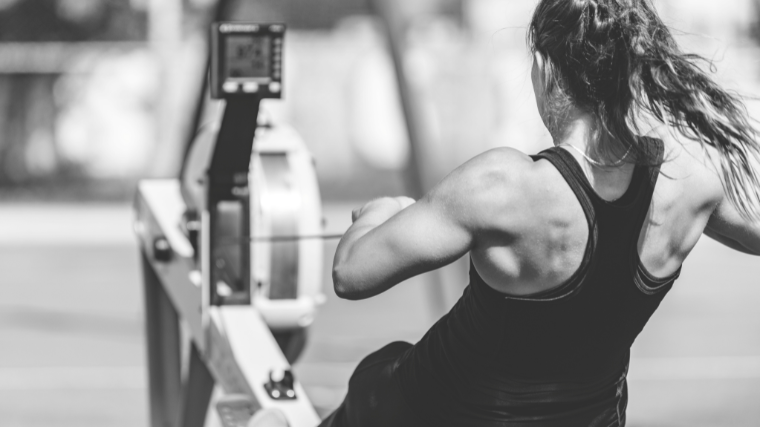
You can engage your entire body in your cardiovascular fitness efforts in a wide variety of ways. In general, these workouts won’t take very long. All-in-all, the versatility of workout types, the rower’s low-impact nature, and the massive conditioning impacts equal a solid cardio option — even if you don’t like cardio.
Active Recovery
It’s not all about going as hard as possible, as often as possible. Five minutes on a rowing machine is a great way to warm up, and a slow and steady 1,000 or 2,000-meter row can be an excellent addition to an active recovery day. Since rowing involves your entire body and has a minimal repetitive impact on your joints, you’ll be able to hop on a rower to shake off the strain of heavy lifting.
Row, Row, Row (Your Machine)
You might be flirting with the idea of trying out that rower in the corner of your gym. Or, you may have been dabbling in rowing workouts for some time and are wondering when you’ll finally feel like you’re getting better at it.
Learning how to use a rowing machine properly — or brushing up on old knowledge — can help you start on the right foot or get even better at your favorite form of cardio. So strap your feet in and row the right way.
Featured Image: UfaBizPhoto / Shutterstock